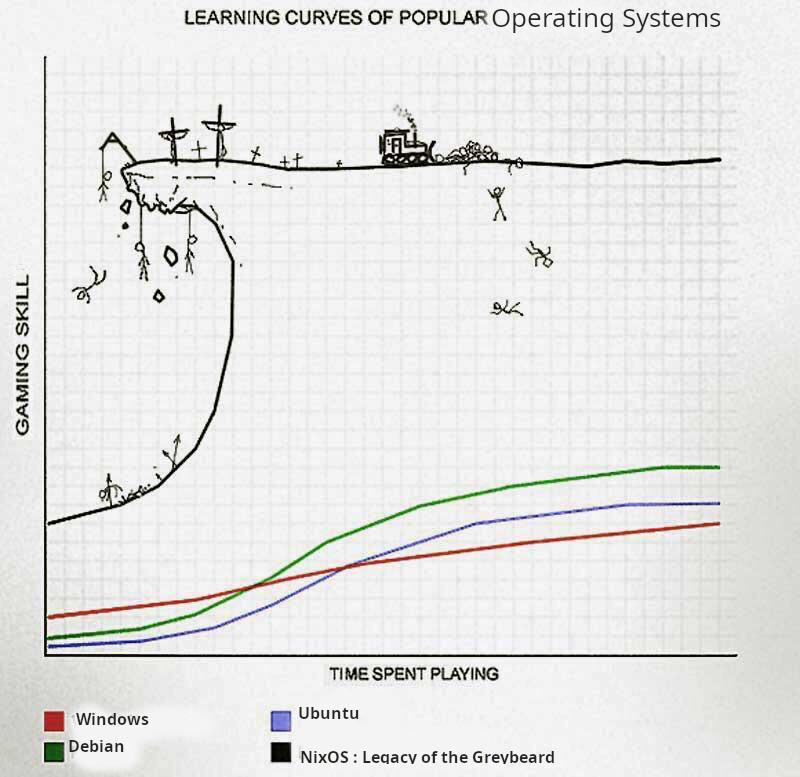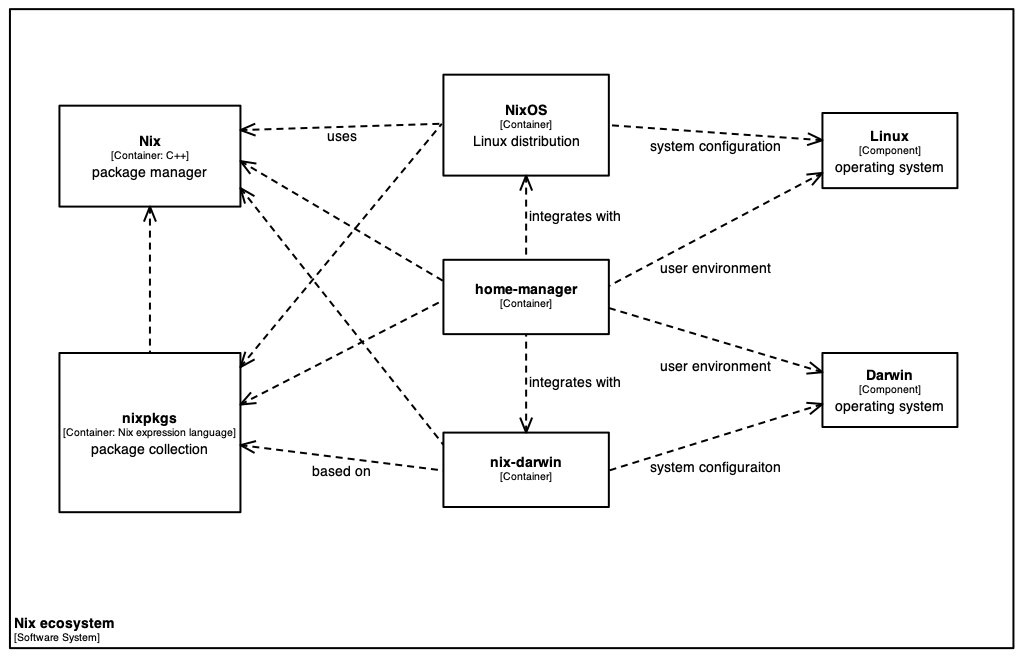The Nix Book
Warning This repository may eventually disappear.
The Nix documentation team now works on nix.dev towards the vision outlined here.
A vision for the journey into Nix, nixpkgs, and NixOS
This book is supposed to fit between first impressions on the Nix web site and the reference manuals for Nix, Nixpkgs, NixOS.
flowchart
subgraph homepage
core --> explore
get-started --> learn
explore --> |details| how-nix-works
subgraph front-page[front page]
subgraph core[core features]
same[always working environment, everywhere]
polyglot[many programming languages]
deploy[configure, build, deploy]
rollbacks[roll back any time]
community[global community]
end
examples
get-started[get started]
end
subgraph explore
complete[complete dependencies]
reproducible[reproducible builds]
correct[correct deployment]
multiple[multiple versions]
atomic[atomic upgrades]
agnostic[many programming languages]
caching[transparent caching]
remote[remote builds]
nixpkgs[community package collection]
nixexpr[purely functional configuration language]
end
subgraph learn
install
first-steps[first steps]
how-nix-works[how nix works]
end
end
first-steps --> book --> manuals --> source
book --> discussion
subgraph book[The Nix Book]
direction TB
build --> imperative-pkgs & declarative-pkgs
declarative-pkgs --> writing --> declarative-config & dev & nixpkgs-learn
subgraph build[run software]
direction LR
find-pkg[find packages]
run[run a program]
shell[set up temporary environment]
end
subgraph imperative-pkgs[imperative package management]
direction LR
install-profile[install]
update
rollback
pin-packages[pin packages]
end
subgraph declarative-pkgs[declarative package management]
direction LR
decl-env[reproducible environment]
compose[compose packages]
adapt[adapt packages]
pin-deps[pin dependencies]
gc[garbage collection]
end
subgraph nixpkgs-learn[package collection]
direction LR
modify[modify existing package]
newpkg[create new package]
contribute-nixpkgs[contribute to nixpkgs]
end
subgraph declarative-config[declarative configuration management]
direction LR
user-env[user environments]
os[operating system distribution]
services[service management]
end
subgraph writing[configuration language]
syntax
functions
attrsets[attribute sets]
debugging
library
tools[tool support]
end
subgraph dev[software development]
direction LR
lang-ecosystems[language ecosystems]
caching
deployment
ci[continuous integration]
distributed[distributed builds]
cross-compilation
bundling[bundling build results]
end
end
subgraph discussion
RFCs
pr[pull requests]
issues
Discourse
end
subgraph manuals
subgraph man-nix[Nix]
cmd[command line interface]
lang[expression language]
config[configuration]
architecture
end
man-nixpkgs[nixpkgs]
man-nixos[NixOS]
end
subgraph source[source code]
nix-src[NixOS/nix]
nixpkgs-src[NixOS/nixpkgs]
end
Contributing
Please consider contributing to this book, especially if
- you are currently learning to use Nix
- you have experience teaching Nix
- you are a domain expert using Nix to solve specific problems.
Motivation
Nix has a proverbially steep learning curve.
Posted by nixinator on NixOS Discourse
The Nix[(pkgs|OS)] manuals, together with the RFCs, Eelco Dolstra’s PhD thesis The Purely Functional Software Deployment Model, NixOS Wiki and nix.dev, are the most comprehensive collection of knowledge on the design of the Nix ecosystem – except for the code base itself. But these resources are dispersed, in varying state of maintenance, do not follow a coherent structure to draw an overarching narrative, and, based on rich anecdata, community folklore, and the 2022 Nix survey, overall are not very effective for onbarding:
Documentation, Documentation, Documentation
Documentation (once again) came up universally across almost all respondents. Key asks in this area revolved around three aspects - onboarding, unblocking and centralization.
- Onboarding - A majority of respondents highlighted trouble in the onboarding phase. The lack of new user documentation meant users have a tough time understanding how to onboard, following the first few steps, understanding best practices and finding general FAQs.
- Unblocking - Respondents heavily emphasized the need for better documentation in the realm of tutorials/guides/examples that can help serve in unblocking themselves.
- Centralization - Many were frustrated with the time it took to locate relevant documentation. Searching for answers took too long and invariably led them to various websites, github repos, and videos - often requiring multiple resources to address the same issue.
There also seems to exist no birds-eye view on the larger ecosystem and the interplay of its components.
Own contribution; does not cover topics such as deployment or support tooling.
Meanwhile, complexity is ever growing with new features, and disparity between what is actually explained and what people use in the field continuously increases.
Nix becomes harder to learn every day.
Project proposal
The goal of the following proposal is to make Nix the package manager as well as its sourrounding tools more accessible to Nix beginners, and enabling expert users to become effective contributors or maintainers.
Write and publish The Nix Book
The Nix Book is supposed to be the living, up-to-date overview on all concepts surrounding Nix.
The main target audience are autodidacts who do not have access to hand-holding or personal training, nor possibility for learning through osmosis. It shall contain explanations of technical principles, design rationale, and architecture of all major components in the Nix ecosystem as it is today.
It can mostly be based on available information; reoganized, reworded, or complemented where necessary. See the proposed outline and compare to current state of documentation for an impression where material can be repurposed. It should be extended with diagrams and illustrations where it would add clarity.
Hypertext allows multiple reading orders through a collection self-contained, but related units. With the right design we can offer multiple coherent access paths into conceptual knowledge; for example breadth-first, depth-first, or free link-surfing.
Ideally there should be usability tests with dedicated or in-line surveys that allow collecting feedback and checking if set learning goals have been met.
Rework the Nix manual
While the main goal is to fill the explanation gap, gaining an overview, building detailed understanding, collecting and restructuring content is already part of the task. Some of that work could therefore entail overhauling the Nix manual to better fit into the new narrative. Nix the package manager is the core component of the ecosystem and also has the smallest single manual, most amenable to structural change.
- develop a strategy to reposition the manual as purely reference material for Nix the package manager and the Nix expression language
- place the purpose statement prominently
- within manual itself
- in contribution guidelines
- find new places for material that does not belong any more
- @edolstra suggests to remove (or adopt in The Nix Book) the following sections
- Introduction
- Quick Start
- Package Management
- The introductory parts of "Writing Nix Expressions"
- Glossary
- place the purpose statement prominently
- triage, collect, or document, and keep track of all existing issues
- conduct, lead, and coordinate attacking the issues by (however determined) priority
- invite and enable domain experts and volunteers
- help with merging their contributions
- develop schemes to improve navigation and discoverability
- links from terms to definitions
- links to source code
Improve discoverability of existing learning material
The results of sorting through and reorganizing material for the book can be made available to the general public and already help with onboarding even before the explanations fully materialize.
- collect and correctly categorize
- similar to or based on an initial survey of existing resources
- through the lens of Backward design
- what are learning objectives and which material achieves which?
- add brief summaries to better orient readers
- rework navigation of learning on nixos.org to incorporate the new structure
- lead readers and contributors to the right places for their types of questions
How is success defined and measured?
In broad terms, The Nix Book and changes to documentation and web site should measurably increase probability of successful onboarding and decrease time to obtain some well-defined skill set.
Part of the tasks would be to define the learning goals, develop test questions to assess to what degree they were reached, and put up questionnaire forms in each chapter to capture the answers.
Since there are no prior metrics, setting up a preliminary questionnaire should be the first publicly visible part, presented for tutorials on the learning page, recurring community surveys, and possibly relevant sections of the manuals.
Results should help direct further work, and help answer questions such as:
- Which questions do newcomers ask most, and do they find satisfactory answers consistent with best practice?
- Which material should we add?
- How should we reorganize existing material?
- How should we improve existing material?
As a consequence we should observe influx of new regular users and contributors to nixpkgs, NixOS, and eventually Nix proper. We currently cannot measure this. Unfortunately we do not gather community metrics, and this is out of this project's scope.
License and Support

This project is sponsored by Tweag.

